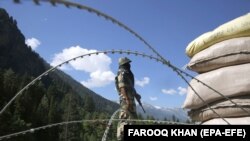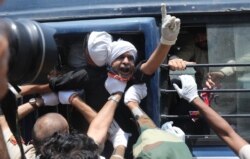In a recent article in the UK Times, a Chinese academic alleged China deployed “microwave weapons” to help reclaim territory during a border standoff in the disputed Himalayan region of Ladakh.
The alleged attack occurred in late August on the southern bank of Pangong Tso Lake. The lake is divided by the Line of Actual Control (LAC), which separates Indian-controlled territory from Chinese-controlled territory. Part of Pangong Tso, some 12 kilometers east of the LAC, is claimed by India but administered by China.
In June, clashes broke out between Indian and Chinese forces in Ladakh’s Galwan river valley, the first such skirmishes since China defeated India in a 1962 war. The hand-to-hand fighting, sometimes at elevations as high as more than 4,000 meters, reportedly left 20 Indian and an unknown number of Chinese soldiers dead.
Following that incident, Jin Canrong, professor of international relations at Renmin University in Beijing, claimed a prohibition on small arms fire and the superiority of Indian soldiers hand-to-hand combat abilities at such altitudes prompted the Chinese to deploy “microwave weapons” to reclaim two strategic hilltops.
“The central military commission was quite furious, ‘How could you be so careless as to let India seize the hilltops?’, so it ordered the ground be taken back, but it also demanded that no single shot be fired,” he said. “Then they came up with the clever idea to use microwave weapons.”
Jin claimed that “within 15 minutes of the weapons being deployed, those occupying the hilltops all began to vomit. They couldn’t stand up, so they fled … This was how we retook the ground.”
On November 17, the Indian military released a statement calling the deployment of microwave weapons in Eastern Ladakh “baseless” and the news “fake”.
Indian defense expert Lt. Gen. P. R. Shankar (Ret.) has dismissed the claim.
Shankar argues that such vehicle-mounted Directed Energy Weapons, (DEWs) like Raytheon’s Active Denial System (ADS) or the Chinese-manufactured Poly WB-1 Anti-Riot System, “tend to be bulky and need large power generators.”
“The WB-1, presented at the [10th China International Aviation and Aerospace Exhibition in Zhuhai] in November 2014, had a range of about 80 meters, though it can be expanded to 1 km. However, achieving ranges of 1 km means considerable extra power. Extra power is always at a premium in high altitudes,” Shankar said.
He further argues such weapons would have to be transported on a “huge truck” or “platform.” At the 2014 air show, for example, the WB-1 Anti-Riot System was mounted on 4x4 truck chassis.
Examining the recent claim, Forbes technology journalist David Hambling said the symptoms described by Jin were not consistent with ADS, which heats the water under the skin, causing an intense burning sensation, but not nausea or an inability to stand up.
He noted, however, that China might have developed another weapon, like the Electromagnetic Personnel Interdiction Control (EPIC) device, which the Pentagon looked into in the early 2000s.
“This uses microwaves to vibrate tiny sensory hairs in the inner ear, disrupting balance and causing dizziness and disorientation. EPIC research appears to have been canceled at an early stage, and such technology is far less advanced than Active Denial.”
As it stands, there is no confirmed use of any such system against civilian or military targets. While the ADS was reportedly deployed to Afghanistan in 2010, it was never used on account of negative public perception.







